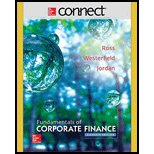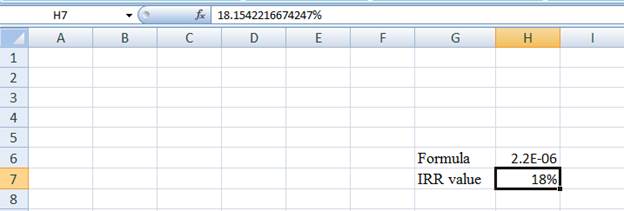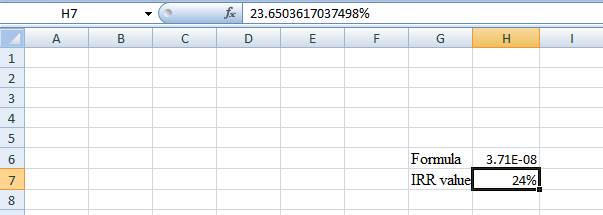
Concept explainers
Comparing Investment Criteria [LO1, 2, 3, 5, 7] Consider the following two mutually exclusive projects:
| Year | Cash Flow (A) | Cash Flow (B) |
| 0 | −$455,000 | −$65,000 |
| 1 | 58,000 | 31,000 |
| 2 | 85,000 | 28,000 |
| 3 | 85,000 | 25,500 |
| 4 | 572,000 | 19,000 |
Whichever project you choose, if any, you require a return of 11 percent on your investment
a. If you apply the payback criterion, which investment will you choose? Why?
b. If you apply the discounted payback criterion, which investment will you choose? Why?
c. If you apply the
d. If you apply the
e. If you apply the profitability index criterion, which investment will you choose? Why?
f. Based on your answers in (a) through (e), which project will you finally choose? Why?
a)
To compute: The payback period.
Introduction:
Capital budgeting is a process, where the business identifies and assesses the potential investments or expenses that are larger in general.
Answer to Problem 17QP
Here, Project B must be accepted as it pays back sooner than Project A.
Explanation of Solution
Given information:
The cash flows for two mutually exclusive projects are $58,000, $85,000, $85,000, $572,000 for Project A respectively for year 1, year 2, year 3, and year 4. Project A has an initial investment of $455,000. The cash flows of Project B are $31,000, $28,000, $25,500, and $19,000 respectively for year 1, year 2, year 3, and year 4. The initial investment for Project B is $65,000. The rate of return is 11%.
Formula to compute the payback period of a project:
Compute the payback period of a project for Project A:
Hence, the payback period is 3.40 years for Project A.
Compute the payback period of a project for Project B:
Hence, the payback period is 2.24 years for Project B.
b)
To compute: The discounted payback period.
Introduction:
Capital budgeting is a process, where the business identifies and assesses the potential investments or expenses that are larger in general.
Answer to Problem 17QP
Here, Project B must be accepted as it pays back sooner than Project A.
Explanation of Solution
Given information:
The cash flows for two mutually exclusive projects are $58,000, $85,000, $85,000, $572,000 for Project A respectively for year 1, year 2, year 3, and year 4. Project A has an initial investment of $455,000. The cash flows of Project B are $31,000, $28,000, $25,500, and $19,000 respectively for year 1, year 2, year 3, and year 4. The initial investment for Project B is $65,000. The rate of return is 11%.
Table showing the calculation of discounted payback period for Project A:
| Year | Net Cash Inflows | ||
| Annual | Today’s value (discounted) at 11% | Accumulated | |
| 1 | $58,000 | $52,252.25
| $52,252.25 |
| 2 | $85,000 | $68,987.91
| $121,240.16 |
| 3 | $85,000 | $62,151.27
| $183,391.43 |
| 4 | $572,000 | $376,794.12
| $560,185.55 |
Formula to compute the discounted payback period:
By the end of the year 3, the recovery amount is shorter than the initial investment. In the year 4, the recovery amount is higher than initial investment. It means the discounted payback period will be in between the year 3 and 4.
Calculate discounted payback period, if initial cost is $455,000:
Hence, the discounted payback period for Project A is 3.72 years.
Table showing the calculation of discounted payback period for Project B:
| Year | Net Cash Inflows | ||
| Annual | Today’s value (discounted) at 11% | Accumulated | |
| 1 | $31,000 | $27,927.93
| $27,927.93 |
| 2 | $28,000 | $22,725.43
| $50,653.36 |
| 3 | $25,500 | $18,645.38
| $69,298.74 |
| 4 | $19,000 | $12,515.89
| $81,814.63 |
Formula to calculate the discounted payback period for Project B, if initial cost is $65,000:
By the end of the year 2, the recovery amount is shorter than the initial investment. In the year 3, the recovery amount is higher than initial investment. It means the discounted payback period will be in between the year 2 and 3.
Calculate the discounted payback period for Project B, if initial cost is $65,000:
Hence, the discounted payback period for Project B is 2.77 years.
c)
To compute: The NPV (Net present value).
Introduction:
Capital budgeting is a process, where the business identifies and assesses the potential investments or expenses that are larger in general.
Answer to Problem 17QP
Here, Project A must be accepted as the NPV is higher in Project A.
Explanation of Solution
Given information:
The cash flows for two mutually exclusive projects are $58,000, $85,000, $85,000, $572,000 for Project A respectively for year 1, year 2, year 3, and year 4. Project A has an initial investment of $455,000. The cash flows of Project B are $31,000, $28,000, $25,500, and $19,000 respectively for year 1, year 2, year 3, and year 4. The initial investment for Project B is $65,000. The rate of return is 11%.
Formula to calculate the NPV:
Calculate the NPV for Project A:
Hence, the NPV for Project A is $105,185.54.
Calculate the NPV for Project B:
Hence, the NPV for Project B is $16,814.63.
d)
To compute: The IRR for the project.
Introduction:
Capital budgeting is a process, where the business identifies and assesses the potential investments or expenses that are larger in general.
Answer to Problem 17QP
Here, Project B must be accepted as the IRR is higher in Project B.
Explanation of Solution
Given information:
The cash flows for two mutually exclusive projects are $58,000, $85,000, $85,000, $572,000 for Project A respectively for year 1, year 2, year 3, and year 4. Project A has an initial investment of $455,000. The cash flows of Project B are $31,000, $28,000, $25,500, and $19,000 respectively for year 1, year 2, year 3, and year 4. The initial investment for Project B is $65,000. The rate of return is 11%.
Equation of IRR of Project A:
Compute IRR for Project A using a spreadsheet:
Step 1:

- Type the equation of NPV in H6 in the spreadsheet and consider the IRR value as H7
Step 2:

- Assume the IRR value as 10%
Step 3:

- In the spreadsheet go to data and select the what-if analysis
- In what-if analysis select goal seek
- In set cell select H6 (the Formula)
- The “To value” is considered as 0 (the assumption value for NPV)
- The H7 cell is selected for the by changing cell
Step 4:

- Following the previous step click OK in the goal seek. The goal seek status appears with the IRR value
Step 5:

- Thevalue appears to be 18.1542216674247%
Hence, the IRRvalue is 18.15%.
Equation of IRR of Project B:
Compute IRR for Project B using a spreadsheet:
Step 1:

- Type the equation of NPV in H6 in the spreadsheet and consider the IRR value as H7
Step 2:

- Assume the IRR value as 10%
Step 3:

- In the spreadsheet go to data and select the what-if analysis
- In what-if analysis select goal seek
- In set cell select H6 (the Formula)
- The “To value” is considered as 0 (the assumption value for NPV)
- The H7 cell is selected for the by changing cell
Step 4:

- Following the previous step click OK in the goal seek. The goal seek status appears with the IRR value
Step 5:

- Thevalue appears to be 23.6503617037489%
Hence, the IRRvalue is 23.65%.
e)
To compute: The profitability index.
Introduction:
Capital budgeting is a process, where the business identifies and assesses the potential investments or expenses that are larger in general.
Answer to Problem 17QP
Here, Project B must be accepted as the PI is higher in Project B.
Explanation of Solution
Given information:
The cash flows for two mutually exclusive projects are $58,000, $85,000, $85,000, $572,000 for Project A respectively for year 1, year 2, year 3, and year 4. Project A has an initial investment of $455,000. The cash flows of Project B are $31,000, $28,000, $25,500, and $19,000 respectively for year 1, year 2, year 3, and year 4. The initial investment for Project B is $65,000. The rate of return is 11%.
Formula to compute the profitability index:
Compute the profitability index for Project A:
Hence, the profitability index for Project A is $1.23.
Compute the profitability index for Project B:
Hence, the profitability index for Project B is $1.26.
f)
To discuss: The project that Person X will select with a reason.
Introduction:
Capital budgeting is a process, where the business identifies and assesses the potential investments or expenses that are larger in general.
Explanation of Solution
Given information:
The cash flows for two mutually exclusive projects are $58,000, $85,000, $85,000, $572,000 for Project A respectively for year 1, year 2, year 3, and year 4. Project A has an initial investment of $455,000. The cash flows of Project B are $31,000, $28,000, $25,500, and $19,000 respectively for year 1, year 2, year 3, and year 4. The initial investment for Project B is $65,000. The rate of return is 11%.
Explanation:
In this case, the criteria of NPV denote that Project A must be accepted, while payback period, discounted payback, profitability index, and IRR denote that Project B must be accepted. The overall decision must be based on the NPV as it does not have the ranking problem when compared with the other techniques of capital budgeting. Hence, Project A must be accepted.
Want to see more full solutions like this?
Chapter 9 Solutions
Connect 1 Semester Access Card for Fundamentals of Corporate Finance
- Problem 2-21 Financial Statements Use the following information for Ingersoll, Incorporated. Assume the tax rate is 23 percent. 2020 2021 Sales Depreciation $ 19,073 $17,436 1,811 1,886 Cost of goods sold 4,729 4,857 Other expenses 1,021 899 Interest 870 1,001 Cash 6,292 6,916 Accounts receivable 8,190 9,877 Short-term notes payable 1,320 1,297 Long-term debt 20,770 25,011 Net fixed assets 51,218 54,723 Accounts payable 4,624 5,094 Inventory 14,538 15,438 1,700 1,768 Dividends Prepare a balance sheet for this company for 2020 and 2021. (Do not round intermediate calculations.) Cash Assets Accounts receivable Inventory INGERSOLL, INCORPORATED Balance Sheet as of December 31 2020 2021 $ 6,292 $ 6,916 8,190 9,877 14,538 15,438 Drov 14 of 20 Nearrow_forwardProblem 6-35 Financial Break-Even Analysis The technique for calculating a bid price can be extended to many other types of problems. Answer the following questions using the same technique as setting a bid price; that is, set the project NPV to zero and solve for the variable in question. Martin Enterprises needs someone to supply it with 152,000 cartons of machine screws per year to support its manufacturing needs over the next five years, and you've decided to bid on the contract. It will cost $1,920,000 to install the equipment necessary to start production; you'll depreciate this cost straight-line to zero over the project's life. You estimate that, in five years, this equipment can be salvaged for $162,000. Your fixed production costs will be $277,000 per year, and your variable production costs should be $10.60 per carton. You also need an initial investment in net working capital of $142,000. The tax rate is 22 percent and you require a return of 12 percent on your investment.…arrow_forwardYou plan to purchase a $100,000 house using a 30-year mortgage obtained from your local credit union. The mortgage rate offered to you is 8.25 percent. You will make a down payment of 20 percent of the purchase price. Calculate the amount of interest and, separately, principal paid in the 225th payment. Calculate the amount of interest paid over the life of this mortgage.arrow_forward
- What are the back ground of Sears problem, and what are the general of the problem statements? How to Create problem statements and applicable research questions? What are the lessons learned from Sears that business people or organization should avoid?arrow_forwardWhat are the research assumptions, and the research limitations, please give examples for each one, and explain how the limitation in the example might be mitigated? What are the research delimitations and give one example please. Hhow Biblical principles are related to reliability and validity.arrow_forwardWhat are the six sources of data collection and please help to explain the qualitative data collection methods. What is the thematic analysis? How to anticipated themes in a research proposal?arrow_forward
- Explain in detail the principle of Compounding of interest and why is it so important in Finance.arrow_forwardWhat is the bond quote for a $1,000 face value bond with an 8 percent coupon rate (paid semiannually) and a required return of 7.5 percent if the bond is 6.48574, 8.47148, 10.519, and 14.87875 years from maturity?arrow_forwardGentherm Incorporated has a convertible bond issue outstanding. Each bond, with a face value of $1,000, can be converted into common shares at a rate of 42.25 shares of stock per $1,000 face value bond (the conversion rate), or $19.85 per share. Gentherm’s common stock is trading (on the NYSE) at $19.85 per share and the bonds are trading at $1,025. Calculate the conversion value of each bond. Note: Round your answer to 4 decimal placesarrow_forward
- You are looking to lease a 2019 Subaru Forester. You have found a 36 - month closed end lease on a Forester with an MSRP of $25, 270 and a lease end purchase option of $15,667 (residual value). To get the lease you have to pay a fee of $1,765 due at signing, and the monthly payment was calculated to be $ 265. A) What is the nominal rate of return the dealership is earning on the lease? (Hint: think of the cash flows from the dealerships prospective) B) What would the lease payment be if the dealership wanted a nominal 6% compounded monthly on the lease?arrow_forwardWhat should business people learn about the problem started with Sears and organizational consequences?How the traditional retail businesses face significant challenges in remaining competitive in the digital age? What is the broad exploration of retail industry challenges without assuming specific causes or outcomes, making them suitable for research and why?arrow_forwardWhat are Biblical principles researchers can follow to mitigate Unintended errors in research?How a Christian conduct during a research proposal and study can be a witnessof the Gospel to others.arrow_forward

 Intermediate Financial Management (MindTap Course...FinanceISBN:9781337395083Author:Eugene F. Brigham, Phillip R. DavesPublisher:Cengage Learning
Intermediate Financial Management (MindTap Course...FinanceISBN:9781337395083Author:Eugene F. Brigham, Phillip R. DavesPublisher:Cengage Learning EBK CONTEMPORARY FINANCIAL MANAGEMENTFinanceISBN:9781337514835Author:MOYERPublisher:CENGAGE LEARNING - CONSIGNMENT
EBK CONTEMPORARY FINANCIAL MANAGEMENTFinanceISBN:9781337514835Author:MOYERPublisher:CENGAGE LEARNING - CONSIGNMENT



